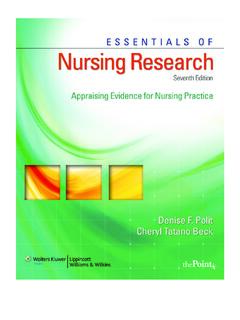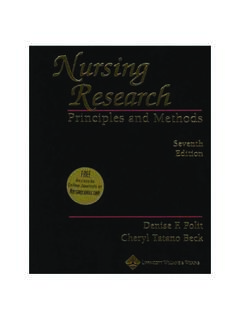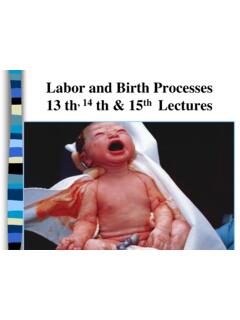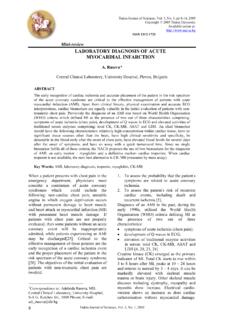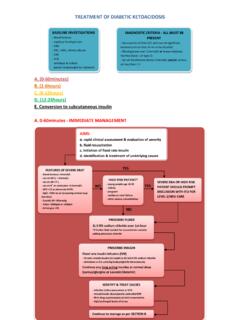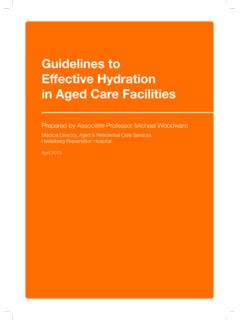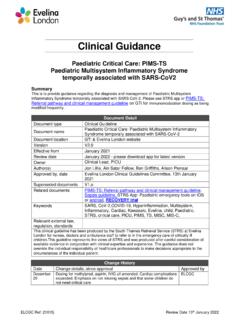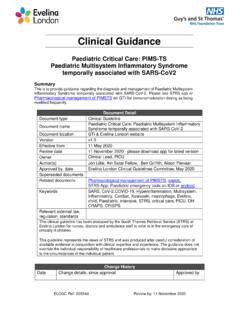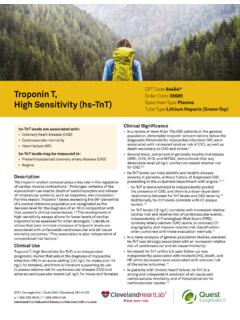Transcription of Patient Assessment: 17 Cardiovascular System
1 Patient Assessment: Cardiovascular SystemPATRICIAGONCEMORTON TERRYTUCKER chapter17211 cardiac History and PhysicalExaminationHistoryPhysical ExaminationCardiac Laboratory StudiesRoutine Laboratory StudiesEnzyme StudiesBiochemical Markers:Myocardial ProteinsNeurohumoral Hormones: Brain-type Natriuretic PeptideNewer Diagnostic MarkersCardiac Diagnostic StudiesNoninvasive TechniquesInvasive TechniquesElectrocardiographic MonitoringEquipment FeaturesProcedureTroubleshootingElectroc ardiogram MonitorProblemsArrhythmias and the 12-LeadElectrocardiogramEvaluation of a Rhythm StripNormal Sinus RhythmArrhythmias Originating at theSinus NodeAtrial ArrhythmiasJunctional ArrhythmiasVentricular ArrhythmiasAtrioventricular BlocksThe 12-Lead ElectrocardiogramEffects of Serum ElectrolyteAbnormalities on theElectrocardiogramPotassiumCalcium Explain possible causes of serum creatine kinaseelevations other than acute myocardial infarctionand ischemia.
2 Describe current techniques used for diagnosticpurposes in cardiology. Discuss the nursing care before and after cardiacdiagnostic studies. Outline the Patient and family teaching appropriateto prepare the Patient for cardiac diagnostic studies. Describe potential complications of cardiacdiagnostic procedures. Explain the major features of an electrocardiogram(ECG) monitoring System . Compare and contrast a hard-wire monitoringsystem with a telemetry monitoring MonitoringPressure Monitoring SystemArterial Pressure MonitoringCentral Venous PressureMonitoringPulmonary Artery PressureMonitoringDetermination of cardiac OutputEvaluation of Oxygen Deliveryand Demand BalanceobjectivesBased on the content in this chapter, the reader should beable to: Explain the components of the Cardiovascular history.
3 Describe the steps of the Cardiovascular physicalexamination. Discuss the mechanisms responsible for the production of the first, second, third, and fourthheart sounds and their timing in the cardiac cycle. Explain each type of murmur, its timing in the cardiac cycle, and the area on the chest wall whereit is most easily auscultated. Compare and contrast the usefulness of serumenzymes and myocardial proteins in diagnosing anacute myocardial application of complex technology to the assess-ment and management of Cardiovascular and car-diopulmonary conditions has increased greatly in thepast several decades. Use of advanced and complex tech-nologies is an integral part of the care of critically ill , the value of a comprehensive cardiovascularhistory and physical examination should never be under-estimated.
4 The chapter begins with a discussion of the car-diac history and physical examination and then discussestechnological assessment HISTORY ANDPHYSICAL EXAMINATIONThe Cardiovascular history provides physiological and psy-chosocial information that guides the physical assessment ,the selection of diagnostic tests, and the choice of treat-ment options. During the history, the nurse asks about thepresenting symptoms, past health history, current healthstatus, risk factors, family history, and social and per-sonal history. The nurse also inquires about behaviorsthat promote or jeopardize Cardiovascular health and usesthis information in guiding health teaching. During theprocess of taking a thorough history and performing a phys-ical examination, the nurse has an opportunity to establishrapport with the Patient and to evaluate the Patient s gen-eral emotional COMPLAINT AND HISTORY OF PRESENT ILLNESSThe nurse begins the history by investigating the Patient schief complaint.
5 The Patient is asked to describe in his orher own words the problem or reason for seeking nurse then asks for more information about the pres-ent illness, using the questions in Box 17-1. Answers tothese questions are essential to understanding the Patient sperception of the problem. The nurse also asks the patientabout any associated symptoms, including chest pain, dys-pnea, edema of feet/ankles, palpitations and syncope,cough and hemoptysis, nocturia, cyanosis, and intermit-tent PainChest pain is one of the most common symptoms ofpatients with Cardiovascular disease. Therefore, it is anessential component of the assessment interview. Chestpain is often a disturbing or even frightening experiencefor a Patient , so the Patient may be hesitant to initiate adiscussion of chest pain.
6 The questions listed in Box 17-1are particularly useful when assessing chest cardiac pain (angina pectoris) is the result of animbalance between oxygen supply and oxygen demand, itusually develops over time. Typically, anginal pain does notstart at maximal intensity. Not all chest pain is cardiac inorigin, and careful reporting of the characteristics of thepain and the behaviors (or lack thereof) that precede theonset of pain is required. The nurse asks the Patient abouthis or her normalbaseline status before the symptoms devel-oped. It is also important to ask about the onsetof the symp-toms to determine the date and time that the symptomsstarted and whether the onset was sudden or pain caused by coronary artery disease is oftenprecipitatedby physical or emotional exertion, a meal, orbeing out in the cold.
7 Palliativemeasures to relieve anginalpain may include rest or sublingual nitrates; these measuresusually do not relieve the pain of a myocardial infarction(MI). The qualityof cardiac chest pain is often described asa heaviness, tightness, squeezing, or choking sensation. If212 PART IVCARDIOVASCULAR System Explain correct electrode placement when moni-toring the standard leads or the chest leads with athree-electrode and a five-electrode System . Discuss steps for troubleshooting ECG monitorproblems. Describe the components of the ECG tracing andtheir meaning. Explain the steps used to interpret a rhythm strip. Describe the causes, clinical significance, and management for each of the arrhythmias discussed. Describe the parameters of a normal 12-lead ECG.
8 Define electrical axis, and determine the directionof the axis for a 12-lead ECG. Explain the causes, clinical significance, and treat-ment for bundle branch blocks, atrial enlargement,and ventricular enlargement. Describe the ECG changes associated with serumpotassium and calcium abnormalities. Analyze the characteristics of normal systemic arte-rial, right atrial, right ventricular, pulmonaryartery, and pulmonary artery wedge pressure waveforms. Describe the System components required to mon-itor hemodynamic pressures. State nursing interventions that ensure accuracy ofpressure readings. Discuss the major complications that can occurwith an indwelling arterial line and pulmonaryartery catheter. Describe the thermodilution method of measuringcardiac output.
9 Identify the determinants of cardiac output. Evaluate the factors influencing oxygen deliveryand consumption. Use Sv O2monitoring to assess oxygen delivery 17 Patient assessment : Cardiovascular System213the pain is reported as superficial, knifelike, or throbbing,it is not likely to be anginal. cardiac chest pain is usuallylocated in the substernal regionand often radiatesto theneck, left arm, the back, or jaw. Although the pain is oftenreferred to other areas, anginal pain is visceral in origin,and most complaints include a reference to a deep, inside pain. When the Patient is asked to point to the painful area,the painful area is about the size of a hand or clenched is unusual for true anginal pain to be localized to an areasmaller than a fingertip.
10 Using a scale of 1 to 10, with 10being the worst pain the Patient has ever experienced, thepatient is asked to rate the severityof the pain. When askedabout time,the Patient with cardiac chest pain reports thepain lasting anywhere from 30 seconds to may be secondary to Cardiovascular problems thatare unrelated to a primary coronary insufficiency. There-fore, when obtaining the Patient s history, the nurse mustconsider other causes. For example, if the Patient reportsthe pain is made worse by lying down, moving, or deepbreathing, it may be caused by pericarditis. If the pain is ret-rosternal and accompanied by sudden shortness of breathand peripheral cyanosis, it may be caused by a occurs in patients with both pulmonary andcardiac abnormalities.





